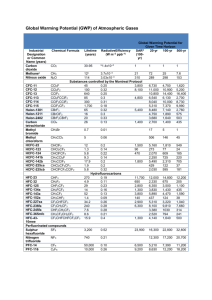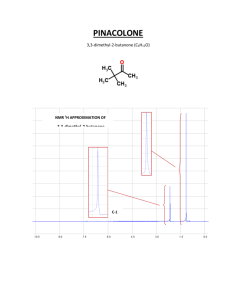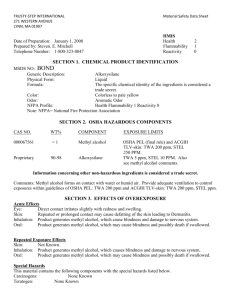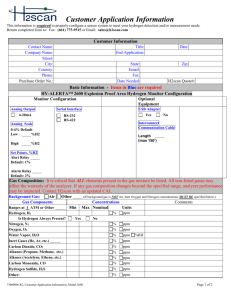Errors in Klien study guide 1st edition
advertisement
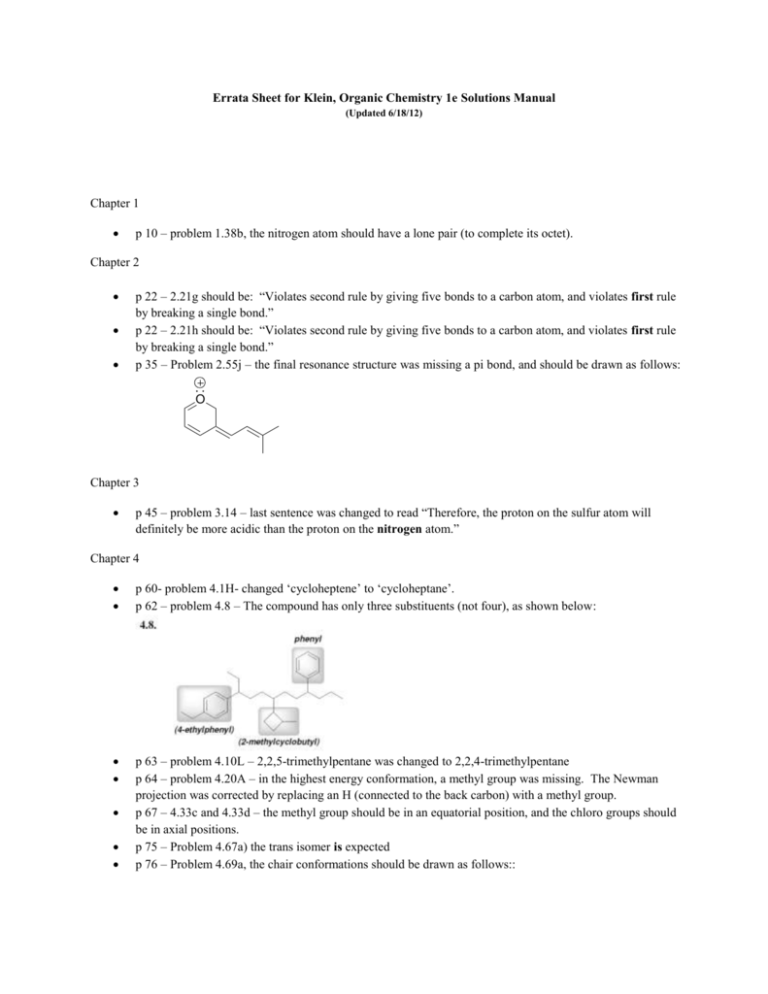
Errata Sheet for Klein, Organic Chemistry 1e Solutions Manual (Updated 6/18/12) Chapter 1 p 10 – problem 1.38b, the nitrogen atom should have a lone pair (to complete its octet). Chapter 2 p 22 – 2.21g should be: “Violates second rule by giving five bonds to a carbon atom, and violates first rule by breaking a single bond.” p 22 – 2.21h should be: “Violates second rule by giving five bonds to a carbon atom, and violates first rule by breaking a single bond.” p 35 – Problem 2.55j – the final resonance structure was missing a pi bond, and should be drawn as follows: O Chapter 3 p 45 – problem 3.14 – last sentence was changed to read “Therefore, the proton on the sulfur atom will definitely be more acidic than the proton on the nitrogen atom.” Chapter 4 p 60- problem 4.1H- changed ‘cycloheptene’ to ‘cycloheptane’. p 62 – problem 4.8 – The compound has only three substituents (not four), as shown below: p 63 – problem 4.10L – 2,2,5-trimethylpentane was changed to 2,2,4-trimethylpentane p 64 – problem 4.20A – in the highest energy conformation, a methyl group was missing. The Newman projection was corrected by replacing an H (connected to the back carbon) with a methyl group. p 67 – 4.33c and 4.33d – the methyl group should be in an equatorial position, and the chloro groups should be in axial positions. p 75 – Problem 4.67a) the trans isomer is expected p 76 – Problem 4.69a, the chair conformations should be drawn as follows:: OH Et Cl Et OH Cl more stable Chapter 5 p 83 – problem 5.16 – The problem asks for the enantiomer, so the observed rotation should be negative, rather than positive. p 84 – The answer is “5.23e has three planes of symmetry” p 90 – problem 5.50c) 5% of the mixture is (S)-carvone p 90 – problem 5.51. The last four solutions were renumbered (m,n,o,p rather than l,m,n,o) Chapter 6 p 95 – Problem 6.1a – Br-Br should be +193kJ/mol and the sum for ΔH⁰ should be -63kJ/mol p 96 – problem 6.4a – the last full sentence on this page was changed to read “A high temperature will cause the second term to dominate, giving rise to a negative value of ΔG. p 97 – problem 6.4a – second line on the page was changed to read “dominate, giving rise to a positive value of ΔG. p 97 – problem 6.4d – the last line of the problem was changed to read “dominate, giving rise to a negative value of ΔG. Chapter 7 p 118 – problem 7.5. The resonance structures of the intermediate were each missing a methyl group. The correct resonance structures are: p 120 – deleted 7.16d, since that exercise does not appear in the text. p 122 – 7.21e and 7.21f – the proton source in the mechanism should be MeOH2+ rather than H3O+ p 124 – 7.24d – the starting material should be benzyl chloride, rather than benzyl bromide p 125 – problem 7.28. Structures in part a and part b should not contain fluoro groups. The fluoro groups were deleted. p 126 – Problem 7.33c. The answer should be: 1) TsCl, py, 2) NaI. p 126 – Problem 7.33i was deleted, because there is no corresponding problem in the text. p 127 – problem 7.36. There were two answers for part d. The second answer was incorrect and was deleted. Also, 7.36f does not appear in the textbook, so the solution for 7.36f was deleted from the solutions manual. Chapter 8 p 147 – problem 8.18b – answer should be: p 147 – problem 8.18c – answer should be: p 155 – problem 8.45 – first sentence was changed to read “The substrate is sterically hindered (severely) so SN2 cannot occur at a reasonable rate. p 163 – Problem 8.70 – The identity of the halogen in the transition state should be Cl, rather than Br. p 164 – Problems 8.75a and 8.75c – sodium ethoxide should be used (sodium hydroxide was not listed as an option in the problem statement) p 166 – 8.78c – the starting material has only one chirality center, and therefore, the methyl group should not be on a wedge. It should be on a straight line. p 167 – problems G and H should be changed to J and L respectively. p 167 – problems J and K – changed as follows: Chapter 9 p 177 – problem 9.7b – the product was missing a methyl group (it should be 3-bromo-3-methylpentane). p 199 – problem 9.74 – changed 1) from NaOMe to tBuOK. Chapter 10 p 216 – problem 10.33A – changed 1) from NaOMe to tBuOK. Chapter 12 p 256 – problem 12.3B - changed 1) from NaOMe to tBuOK. Chapter 13 p 289 – Problem 13.22d was mislabeled as 13.22c. p 291- the top four solutions were renumbered (c,d,e,f rather than d,e,f,g) Chapter 14 p 319 – Problem 14.12a – the second name given should be: 2,2-dimethyloxirane p 319 – Problem 14.12b – the second name given should be: 2,2-diphenyloxirane p 319 – Problem 14.13a – the second name given should be: (S)-2-methyl-2-phenyloxirane p 319 – Problem 14.13b – the second name given should be: (1R,2R)-2-ethyl-3-propyloxirane p 319 – Problem 14.13c – the second name given should be: (1S,2R)-2-isopropyl-3-methyloxirane Chapter 15 p 347 – problem 15.10E – change to ketone p 347 – problem 15.10F – change to ROH p 351 – The third sentence in the answer should be: “The second spectrum has a peak at M-15, signifying the loss of a methyl group. ” p 353-354 – Problem 15.40a-d should also mention the Csp3-H stretching signals that are expected just below 3000 cm-1. p 354 – Problem 15.42a-f should also mention the Csp3-H stretching signals that are expected just below 3000 cm-1. Chapter 16 p 365 – problem 16.7A – see change below (boxed in red) p 365 – problem 16.7B – see change below (boxed in red) p 366 – The structure for problem 16.7d was changed in the textbook (to avoid having the issue of diastereotopic protons). The answer for the corrected structure is: methyl protons (CH3) = 0.9 ppm alpha to the oxygen = + 2.5 ppm 3.4 ppm methyl protons (CH3) = 0.9 ppm beta to the carbonyl = + 0.2 ppm 1.1 ppm O H3C O H H CH3 H H methylene protons (CH2) = 1.2 ppm alpha to the carbonyl = + 1.0 ppm 2.2 ppm methylene protons (CH2) = 1.2 ppm alpha to the oxygen = + 2.5 ppm alpha to the carbonyl = + 1.0 ppm 4.7 ppm p 370- problem 16.16 – sentences were added: “The following is just one possibility. There are many correct answers.” p 372 – problem 16.21 - the last four solutions were renumbered (c,d,e,f rather than d,e,f,g) p 372 – Problem 16.21e – the structures were changed to avoid having diastereotopic protons. The correct answer should be : “The first compound will have only two signals in its 1H NMR spectrum, while the second compound will have four signals.” Chapter 17 p 393 – problem 17.17 – change s trans to s-cis in both instances p 393 – problem 17.18 – change s-cis to s trans in both instances p 397 – Problem 17.28 – the second structure and the third structure were missing a methyl group. p 408 – Problem 17.65 – the penultimate structure, as well as the previous structure, was missing a methylene group next to the carbonyl group. The missing methylene group was inserted into each of these structures. Chapter 18 p 413 – The last answer should be labeled 18.e rather than 18.1f p 413 – Problem 18.2b – the answer should be 5-bromo-2-hydroxytoluene p 414 – problem 18.5b – the answer should be: 3-methylperoxybenzoic acid or meta-methylperoxybenzoic acid p 426 – problem 18.61A – last sentence was changed to read “The ring with oxygen is not aromatic and not planar. Chapter 19 p 436 – Problem 19.1 – In the last step of the mechanism, the base that removes the proton should be an acetate ion. p 445 – Problem 19.37a – the answer should read: “Each additional nitro group serves as a reservoir of electron density and provides for an additional resonance structure in the Meisenheimer complex, thereby stabilizing the Meisenheimer complex and lowering the energy of activation for the reaction.” p 445 – Problem 19.37b – the answer should read: “No, a fourth nitro group would not be ortho or para to the leaving group, and would not provide resonance stabilization for the Meisenheimer complex. Therefore, we do not expect the temperature requirement to be significantly lowered” p 447 – problem 19.43 – this problem was changed in the textbook - ethylbenzene was replaced with toluene. As a result, the solution was changed as well. The reagents should be CH3Cl and AlCl3, rather than EtCl and AlCl3. This change was necessary in order to enable the next step (formation of tribromomethylbenzene) to be performed. p 462 – problem 19.72A – 5) was changed from Br2, AlBr3 to xs Br2, AlBr3 Chapter 20 p 475 – problem 20.11 – the answers for parts b and c were out of order. p 489 – problem 20.41A – change 1) from BH3 THF to Br2, hv p 489 – problem 20.41E – the last reagent should be isopropyl amine. p 490 – problem 20.41h was deleted, since there is no corresponding exercise in the textbook. p 492 – problem G – see change below (circled in green) p 494 – The answer to problem 20.49 was changed to be: “The carbonyl group of a ketone is unlikely to appear at C-1 because if it did, the compound would likely be called an aldehyde rather than a ketone. There are exceptions, such as 1-phenylketones (one example is 1-phenyl-1-butanone). ” p 497 – problem 20.58 – see change below (circled in green) p 499 – problem 20.63 – a solution was absent. The problem has five parts (a-e), and only four solutions were shown (a,b,c, and e). The missing solution (d) was inserted. Solution to d) is below: p 506 – solution (e) – NBS was changed to Br2 - see change below (circled in green) p 512 – problem 20.85 – the product is called metaformaldehyde (not paraformaldehyde). Chapter 21 p 522 – problem 21.16 – added a p 523 – problem 21.18C – remove 2) and renumber 1, 2, 3. See correction below p 525 – problem 21.22 – changed CH3I to CH3CH2I. See correction below p 525 – problem 21.23 A & B – changed CH3I to CH3CH2I. See correction below see change below (circled in green) p 532 – problem 21.37A – An alternate, more efficient preparation for acetaldehyde is presented (circled in green below): p 532 – problem 21.37C – An alternate, more efficient preparation for acetaldehyde is presented (circled in green below): p 546 – Exercise 21.72 – The second intermediate (generated by expulsion of the chloride ion) should have a positive charge, as shown below: Chapter 22 p 587 – Exercise 22.78a – the target structure was changed in the textbook, so the solution was changed accordingly. The reagent in the second step should be PhCH 2Br and the product is PhCH2CH2COOH. p 588 – Exercise 22.79a – the target structure was changed in the textbook, so the solution was changed accordingly. The reagent in the second step should be PhCH 2Br and the product is PhCH2CH2COCH3. Chapter 23 p 621 – Exercise 23.30d – The first reagent in the first step should be (CH3)3CCl, rather than (CH3)3Cl. Chapter 24 p 655 – Exercise 24.53c – The alpha anomer was shown instead of the beta anomer. The answer should be the beta anomer, shown below: HOCH2 O OH OH HO OH Chapter 26 p 695-696 – The solutions to exercises 26.20 – 26.23 were out of order and were misnumbered. They were placed in the correct order and renumbered accordingly.
